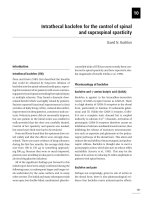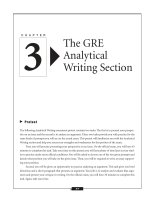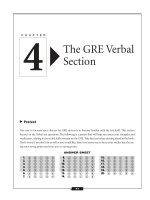Tips for the Quantitative Section of the GRE
Bạn đang xem bản rút gọn của tài liệu. Xem và tải ngay bản đầy đủ của tài liệu tại đây (30.07 KB, 8 trang )
Tips for the Quantitative Section of the GRE
Copyright 2003. www.IvyLeagueAdmission.com.
Published in the USA
All rights reserved. No part of this work may be reproduced or stored
in any form without the prior written consent of the publisher.
The quantitative section of the GRE contains 28 multiple choice-
questions in a 45-minute period. The questions include two formats:
a) standard multiple choice
b) quantitative comparison
The math topics include arithmetic, basic algebra and geometry (no
proofs). Trigonometry and calculus are NOT included. The test
writers carefully choose questions to eliminate biases toward
candidates with specific majors: all test takers will be on a level
playing field. The section is designed to test your ability to solve
problems, rather than your mathematical knowledge. Questions
lean heavily toward word problems and applying mathematical
fomulas in typical real-world applications, such as:
* calculating interest on a loan
* calculating the percenaget drop of a stock price
* determining a salary increase
* determining travel times and speeds
* determining work schedules
While test writers vary their question types from year to year, topics
tend to appear with similar frequency. Recent exam questions fell
into the following categories:
Ratios, Rates, Percentages 25%
Word Problems 25%
Number Properties 25%
Geometry 20%
Other 5%
Nearly every test question has a simple solution and can be solved
with a minimum of calculations. In fact, quantitative comparison
questions often require NO calculating, asking you to simply
determine whether the quantity in Column A or Column B is greater.
The trick is to correctly assess each question and apply the correct
formulas to get the right answer. For standard multiple choice
questions, you have the advantage of the correct answer being right
in front of you. You KNOW it is one of the five listed choices.
Tips & Strategies for Success
1) Read and thoroughly review the math topics that are tested. Work
on areas where you need improvement. Practice each question type
until you are confident you can succeed.
2) Know the directions for each section cold. We list them below for
both the standard multiple-choice section and for the quantitative
comparison questions. The quantitative comparison options are
particularly confusing and bear close scrutiny. Don't waste a
moment of valuable time on your test day reading the directions.
Directions for problem-solving questions: For each of the
following questions, select the best of the answer choices.
Numbers: All numbers used are real numbers.
Figures: The diagrams and figures that accompany these questions
are for the purpose of providing information useful in answering the
questions. Unless it is stated that a specific figure is not drawn to
scale, the diagrams and figures are drawn as accurately as possible.
All figures are in a plane unless otherwise indicated.
Instructions for Quantitative Comparison Questions:
Directions: Each of the following questions consists of two quantities,
one in column A and another in Column B. You are to compare the
two quantities and answer
(A) if the quantity in Column A is greater
(B) if the quantity in Column B is greater
(C) if the two quantities are equal
(D) if the relationship cannot be determined from the
information given
Common information
: In a question, information concerning one or
both of the quantities to be compared is centered above the two
columns. A symbol that appears in both columns represents the
same thing in Column A as it does in Column B.
3) Read each question carefully to understand what you are being
asked. The alternate answer choices are usually chosen to reflect
typical mistakes test takers make when they misread the question. (If
the question asks for the x-intercept, you can be fairly certian the y-
intercept will be one of the wrong answer choices!)
4) Determine immediately whether the problem is simple or complex.
The test questions vary from easy to very difficult but are not
presented in any particular order. You should determine quickly
whether the question is an "easy point" that you can answer
immediately, or whether it requires multiple calculations.
5) Do all easy questions first, leaving the more time-consuming and
difficult ones for later. Many test takers cannot finish the quantitative
section in the time given. Make sure that you quickly earn as many
easy points as possible. The time to struggle with that monster
calculation is AFTER you've answered every other question on the
test.
6) Before solving a problem, read all the answer choices. They will
all be in the format that your own solution should take. Are the
answers in miles per hour, centimeters, fractions?
7) Eliminate choices that are completely off-track. Many are chosen
to correspond to typical mistakes you may make if you misread the
question or miscalculate. Eliminate those that simply don't make
sense as well, such as distances that are negative or % that are
obviously too high or low.
8) Look for shortcuts. The test is measuring your ability to reason,
not to make endless calculations. If you find yourself spending too
much time doing compelx calculations, stop and re-think the question.
you probably missed a crucial shortcut or simple equation that can be
used to solve the problem quickly.
9) Don't obsess on any one problem. If you get stuck, skip the
question and go on to the next one. Skip the spot on your answer
sheet and circle the whole question that you are skipping on the test
sheet. This way, if you have a moment or two at the end to come
back to it, you can find it quickly.
10) Use the substitution (or backsolving) method whenever possible.
Some problems are solved fasted by simply plugging in the five
answer choices and finding the one that works.
11) If you are testing answer choices randomly, start with Choice C.
The five choices are always listed in order, either ascending or
descending. By testing C first, you are trying the "middle" answer. If
it's too large, you only need to check the two smaller answers. This
quickly eliminates working with the other two incorrect answer
choices.
12) If a problem lists only unknowns, try substituting real numbers.
for example, consider the following:
If n is an odd integer, which of the following must be an
EVEN integer?
Substitute an odd integer (such as 3) for n into all of the answer
choices until you have eliminated all but the correct answer. Such
calculations usually just take a a few seconds and quickly solve a
potentially cumbersome problem.
13) Circle all words in the question that may confuse you. Typical
words include not, except and but. Consdier the following question:
A survey of 50 people revealed that 42 of them had eaten at
restaurant B and that 37 of them had eaten at restaurant G. Which of
the following could not be the number of people in the surveyed
group who ate at both B and G.
The word "not" in the question means you are looking for the one
answer that doesn't work, rahter than the four that could.
Overlooking just this one word changes everything.
14) Most figures are drawn to scale. If they are not, the test writers
will tell you otherwise. do NOT, however, assume that an angle is a
right angle unless it is specifically stated in the question.
15) Be prepared to break complex figures into smaller, simpler ones.
Many times a diagram will show an odd-shaped polygon and ask you
to determine an area, side length or perimeter. Upon closer
inspection, this polygon is actually two triangles that share a common
side. The problem is usually easily solved using the Pythagorean
theorem or another basic formula. This "trick" is the key to correctly
solving a number of geometry questions on the exam.
16) Be ready to draw a diagram to solve word problems. Older
versions of the test offered sketches for most geometry problems.
Increasingly, test writers present the problem verbally, requiring the
student to draw his/her own picture of the scenario. In many cases, a
diagram is the fastest way to assess a problem, organize information
and find the solution.
17) Be prepared to read data from graphs and charts. Increasingly,
test writers present data in a tabulated form and ask general
questions about percent increases and deceases. Handle the
questions the same way as you would any similar problem.
18) If you've tried everything else (substitution, backsolving, etc.) and
STILL can't solve a problem, don't sweat it. Just guess. Your
chances for success are 20% for multiple choices questions, 25% for
quantitative comparisons and up to 50 % if you can eliminate a few
incorrect answer choices.
Tips for Quantitative Comparison Questions
Quantitative comparison questions offer unique opportunities and
challenges. Your job isn't to solve a problem, just to determine
whether one quantitiy is greater than another. In addition to all of the
general tips and strategies listed above, keep the following in mind
when answering quantitative comparison questions:
1) If the quantities are expressed in different forms, make them look
alike. Eliminate parentheses and factor out expressions. In
geometry formulas, convert a given measurement (such as an area,
perimeter or volume) to the formula that it represents.
2) Consider the two columns to be sides of an equality. Whatever
you do to one side, do to the other. (The only operations that you
cannot do without potentially changing the relationship between the
two sides are multiplying and dividing by a negative number.)
3) If the problem includes variables, try substituting numbers to make
the relationship clearer. Choose numbers that are easy to work with.
Try to find a second set of numbers that will alter the relationships.
Make sure the relationship holds for positive numbers, negative
numbers and fractions.
4) Choice D is correct in cases when you can demonstrate two
different relationships between the columns. If the quantities both
contain only numbers, Choice D is never correct.
5) Beware of common traps. One trap is the use of squares: the
square root of 25 can be either +5 or -5.
6) Remember your goal: to determine whether one side is larger
than another. Stop working on the question the second you have
enough information. Do NOT bother doing any additional
calculations.
Examples of Quantitative Comparison Questions:
Column A Column B
When 1 is added to the square of B, the result is 65.
1) B 8
k/h = e/4
k, h, and e are positive
2) 6k 2he
j is greater than 1
3) The number of minutes in j hours 60 / j
Answers to Quantitative Comparison Questions:
1. Choice D is correct. While 65 = (8)(8) +1, we cannot assume that
B = 8. B could also be -8. Since B could be either +8 or -8, we must
select D.
2) Choice B is correct. We convert both sides of the "equation" to
make them look alike. Divide both columns by 6h. We discover that
e/3 > h/k.
3) Choice A is correct. The number of minutes in j hours is 60j.
Since j > 1, Column A is the greater quantity.









